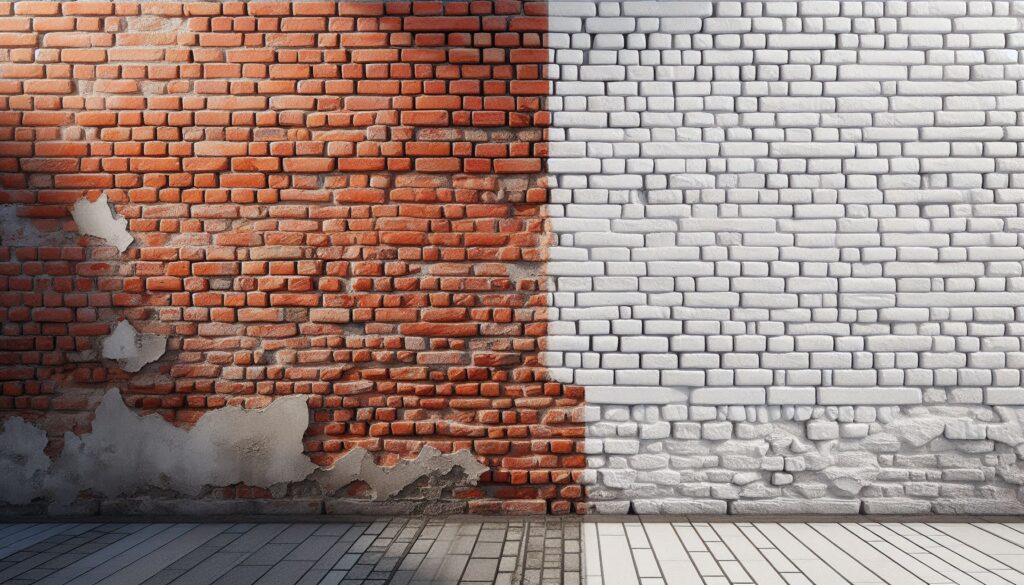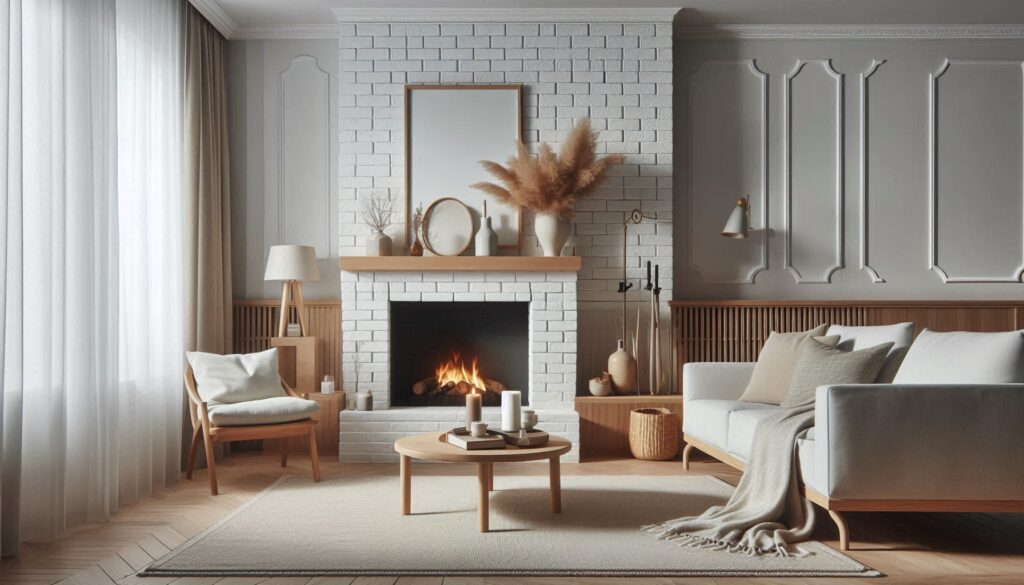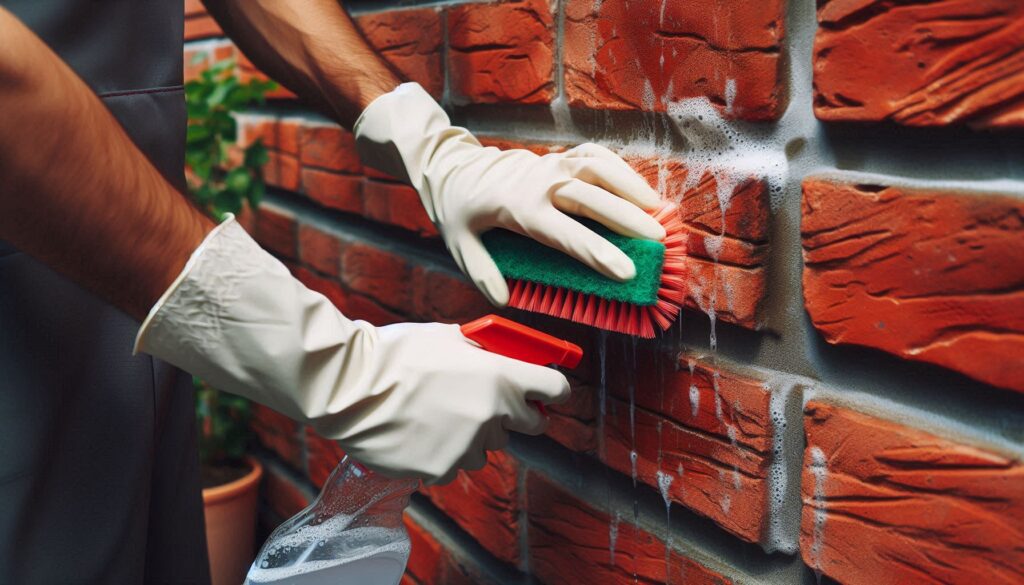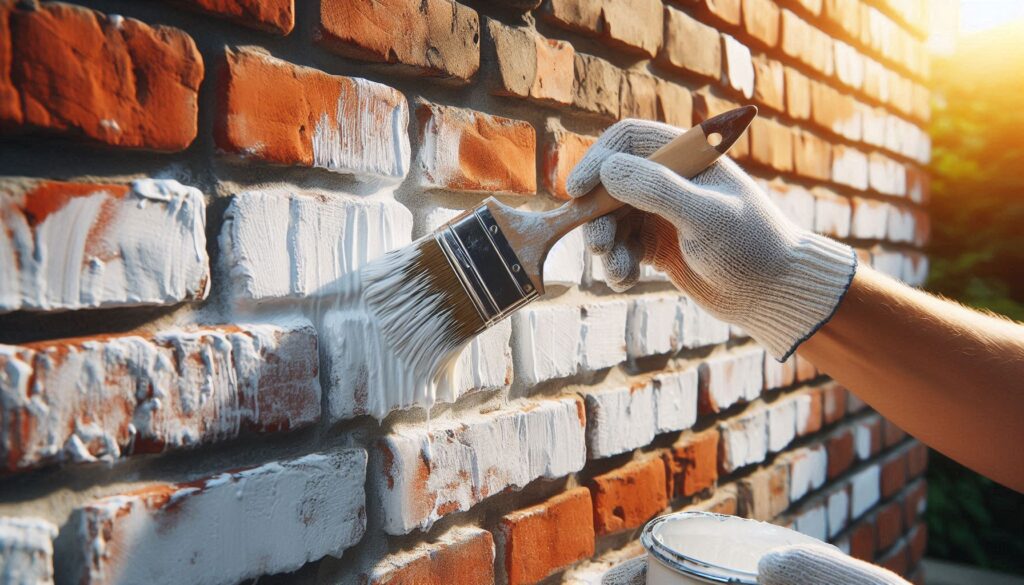Discover why white brick stain is a modern, durable alternative to paint. Learn its benefits, types, cost, and how to apply it for a timeless brick finish.
1. Introduction
Bricks have consistently been a favored construction material because of their strength and enduring charm. But as design trends evolve, many homeowners seek ways to refresh their brick surfaces—especially when looking for a clean, modern aesthetic. Traditionally, painting has been the go-to solution for updating brick, but it often comes with long-term drawbacks like peeling, trapping moisture, and frequent maintenance.
In recent years, white brick stain has emerged as a sleek and sustainable alternative to painting. Unlike paint, which merely coats the surface, a stain penetrates the brick, preserving its natural texture and allowing it to breathe. This technique is gaining popularity among homeowners, renovators, and builders for both interior and exterior applications.
In this post, we’ll explore everything you need to know about white brick stain, why it’s a better choice than paint, and how to apply it for a lasting transformation.
2. What is White Brick Stain?
White brick stain is a specialized coloring solution designed to change the color of brick without covering up its natural texture. It seeps into the pores of the brick, bonding chemically rather than forming a surface layer like traditional paint.
What Is It Made Of?
Brick stains are typically water-based or mineral-based solutions. They contain color pigments suspended in a base that allows the stain to soak into the masonry. Some stains also include binders to enhance durability and adhesion.
How It Works
The key difference between stain and paint lies in penetration. While paint forms a layer on the surface, a stain penetrates the porous material. This helps retain the natural look of the brick while still updating its color.
Stain vs. Paint: Key Differences

Appearance: Stains maintain the original texture; paint can make bricks look flat or fake.
Durability: Stains last longer without flaking or peeling.
Moisture Control: Because stains are breathable, they reduce the risk of trapped moisture and mold buildup.
Maintenance: Stained surfaces require less upkeep over time.
3. Advantages of White Brick Stain Over Paint
Choosing white brick stain over paint offers a range of benefits for both aesthetics and functionality.
- Long-Lasting Finish
White brick stain tends to last longer than paint because it binds with the brick itself. Unlike paint that can chip or peel within a few years, stain wears naturally and evenly over time.
- Breathability and Moisture Control
Bricks are porous and need to breathe. Paint traps moisture inside the brick, leading to issues like efflorescence, mold, or even structural damage. Stains allow moisture to escape, maintaining the health of your walls.
- Retains Brick’s Natural Texture
The natural beauty and texture of brick are maintained with stain. This is especially important for older or rustic-style homes where character matters.
- Better UV Resistance
Many white brick stains include UV-resistant pigments, which means the color won’t fade as quickly under sunlight compared to exterior paint.
- Maintenance Benefits
Since stain does not chip or crack, it demands less maintenance. Occasional washing is often enough to maintain its fresh appearance.
4. Ideal Applications for White Brick Stain

White brick stain is incredibly versatile and can be used in a variety of residential and commercial settings. Whether you’re enhancing curb appeal or modernizing an indoor space, white brick stain provides a fresh, clean look without hiding the brick’s original character.
Home Exterior Walls
One of the most popular uses is on exterior brick facades. Staining gives homes a bright, modern appearance and blends well with other contemporary materials like wood, glass, and steel.
Interior Accent Walls
In the realm of interior design, white brick walls contribute a sense of charm and elegance. Stained bricks make great accent walls in living rooms, kitchens, and entryways—giving the space a crisp and timeless look.
Fireplaces and Chimneys
Fireplaces often become the visual centerpiece of a room. Staining the brick white helps it stand out without overwhelming the space, giving it a cozy yet updated appearance.
Garden Walls and Patios
Outdoor retaining walls, brick fencing, and garden features benefit from staining as it adds aesthetic appeal while withstanding the elements.
Commercial Building Upgrades
White brick stain is also used in commercial renovations where maintaining structural integrity and reducing maintenance costs are important.
5. Types of White Brick Stain
Not all stains are the same. Choosing the right type of white brick stain depends on the look you’re going for, the brick type, and the location (interior or exterior).
Transparent vs. Opaque Stains
Transparent stains allow the brick’s natural variations and imperfections to show through. Perfect for achieving a rustic or vintage aesthetic.
Opaque stains offer more uniform color and can help mask imperfections in older or worn bricks.
Pre-Mixed vs. Custom Blends
Pre-mixed stains are convenient and consistent in color.
Custom blends allow for more flexibility, especially if you’re trying to match existing architecture or design elements.
Water-Based vs. Mineral-Based Stains
Water-soluble stains are environmentally friendly, simpler to use, and appropriate for a variety of indoor uses.
Mineral-based stains bond chemically with masonry and are more durable in harsh outdoor environments. These are ideal for long-term projects.
6. Step-by-Step Process: How to Apply White Brick Stain
Applying white brick stain is a straightforward process, but proper preparation and technique are essential for lasting results.
Step 1: Clean the Brick Surface

Use a stiff brush and mild detergent to remove dust, dirt, or mildew. For exterior bricks, a pressure washer can be used carefully. The more pristine the surface, the stronger the stain will bond.
Step 2: Test on a Small Area
Always do a patch test on a hidden section to check how the brick reacts to the stain and ensure the color is what you want.
Step 3: Choose the Right Tools
Use a brush, roller, or paint sprayer depending on the area size. Brushes are effective for intricate sections, whereas sprayers are more efficient for expansive areas.
Step 4: Apply the Stain

Apply in uniform layers, beginning at the top and progressing downward. Avoid over-saturating the brick, as this can cause dripping or blotching.
Step 5: Let It Dry
Allow the stain to dry according to the manufacturer’s instructions—usually a few hours. Apply a second coat if necessary for a more solid appearance.
Step 6: Optional – Seal the Surface
For added protection, especially in high-traffic or outdoor areas, apply a breathable masonry sealer. This can enhance durability and help resist stains and dirt buildup.
7. Cost Comparison: Stain vs. Paint
When deciding whether to stain or paint brick, the cost frequently plays a significant role. While both options can transform the look of your brick, their pricing and long-term value differ significantly.
Material Cost
White brick stain is often more affordable per gallon compared to high-quality masonry paint.
Stain typically covers more square footage since it penetrates the surface instead of forming a thick coat.
Labor Cost
Staining is less labor-intensive, especially if you’re not applying multiple coats.
Since brick doesn’t require priming before staining (unlike painting), professional labor costs may also be lower.
Long-Term Maintenance
Paint may require touch-ups or complete repainting every 5–7 years due to peeling or fading.
White brick stain lasts longer and wears naturally, leading to lower maintenance costs over time.
Verdict: While the upfront cost of materials and labor may be comparable, brick stain provides better long-term value due to its durability and minimal upkeep.
8. Common Mistakes to Avoid
Even though staining brick is relatively easy, certain mistakes can affect the final result and longevity of the application.
- Skipping Surface Preparation
Dirty, dusty, or moldy bricks can prevent the stain from adhering properly. Always ensure the surface is cleaned thoroughly before beginning.
- Not Testing the Stain First
Stains can look very different once applied to real brick. Skipping a patch test may lead to unwanted shades or uneven absorption.
- Applying Stain to Painted Brick
Brick stain only works on raw, porous surfaces. If your brick has been previously painted, you’ll need to remove the paint first—a tedious and expensive process.
- Over-Applying the Stain
Using too much stain at once can lead to uneven coloring, blotches, or drip marks. Apply in thin, controlled layers.
- Choosing the Wrong Stain Type
Utilizing indoor stain outside or outdoor stain indoors may weaken durability. Make sure to select a stain that’s designed for your specific environment and brick type.
9. FAQs About White Brick Stain
Below are responses to common questions that homeowners often ask regarding the use of white brick stain:
Can I Stain Over Painted Brick?
No, stain will not adhere to painted surfaces. The brick must be raw and porous for the stain to be effective.
How Long Does White Brick Stain Last?
With proper application, white brick stain can last 10–15 years or more, especially if sealed and maintained well.
Is White Brick Stain Permanent?
Yes, most stains chemically bond with the brick and are considered semi-permanent. While it fades slowly over time, it doesn’t peel or crack like paint.
Can I Change the Color Later?
Yes, but only darker stains can be applied over lighter ones. If you’re looking to lighten it up once more, you might have to either eliminate the stain or cover it with paint.
Will the Brick Still Look Natural?
Absolutely. One of the biggest advantages of brick stain is that it preserves the natural texture and details of the brick, unlike paint which can mask them.
10. Final Thoughts

White brick stain has quickly become the modern go-to alternative to painting for homeowners, designers, and builders looking to update brick surfaces without compromising their natural beauty. Its ability to enhance aesthetics, improve durability, and reduce maintenance makes it a smart and sustainable choice for both interior and exterior applications.
Unlike paint, which forms a surface layer prone to peeling and moisture problems, stain penetrates the brick, preserving its texture while offering long-lasting color and protection. Whether you’re giving your home’s facade a fresh look, upgrading an old fireplace, or transforming an accent wall—white brick stain delivers a clean, timeless finish that stands the test of time.
If you’re planning a brick makeover, consider stain not just as a style choice, but as an investment in the longevity and integrity of your structure. It’s a small change with a big, beautiful impact